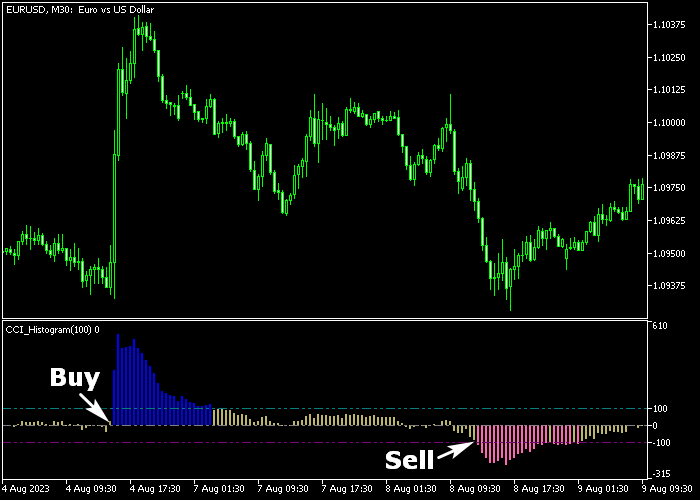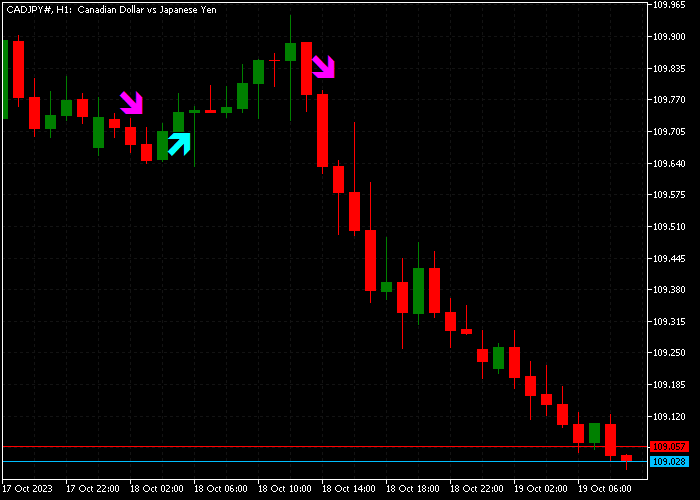The CCI Breakout Histogram indicator for MetaTrader 5 is a standalone Forex trading tool that offers precise trade entry points in both trending and sideways moving markets.
This indicator performs well across all time frames and suits scalpers and day traders best.
Buying and selling currency pairs is a straightforward process and works as follows:
- A buy signal is confirmed when the first blue-colored CCI breakout bar appears above the 0 level.
- A sell signal is confirmed when the pink-colored CCI breakout bar appears below the 0 level.
The indicator includes several inputs and parameters, such as CCI period, extreme levels, colors, etc.
Before implementing it in live trading, it’s advisable to become familiar with this technical indicator and thoroughly test it on a demo account for an extended period.
Download Indicator
cci-histogram-round.mq5 Indicator (MT5)
Trading Chart Example
The picture below illustrates the CCI Breakout Histogram indicator when applied to the MT5 chart.
How To Buy And Sell Using The CCI Breakout Histogram Indicator?
Find a simple trading strategy below:
Buy Signal
- A buy signal is generated when the blue-colored CCI breakout bar is shown on the chart.
- Open a buy market order and set a protective stop loss below the most recent support level.
- Close the buy transaction for a predetermined profit target that suits your preference.
- Alternatively, await a sell signal to close the buy trade.
Sell Signal
- A sell signal is generated when the pink-colored CCI breakout bar is shown on the chart.
- Open a sell market order and set a protective stop loss above the most recent resistance level.
- Close the sell transaction for a predetermined profit target that suits your preference.
- Alternatively, await a buy signal to close the sell trade.
Download Now
cci-histogram-round.mq5 Indicator (MT5)
CCI Breakout + Double Inside Bars Strategy for MT5
This trading strategy combines the power of the CCI Breakout Histogram Indicator with the Double Inside Bars Indicator to deliver high-probability entries during market consolidations and breakouts.
It’s best used on the 15-minute to 1-hour timeframes for forex pairs with moderate to high volatility.
Strategy Overview
This method identifies periods of market consolidation using the Double Inside Bars Indicator, then confirms breakout direction with momentum signals from the CCI Breakout Histogram Indicator.
Buy Entry Rules
- Wait for a valid double inside bar pattern to form.
- Confirm a bullish breakout above the high of the outer candle.
- Check that the CCI Breakout Histogram shows a green histogram bar, indicating bullish momentum.
- Enter a buy trade at the breakout candle’s close or on a slight pullback.
- Place a stop-loss a few pips below the low of the outer bar.
- Target a 1:2 or 1:3 risk-to-reward ratio, or use trailing stops for extended moves.
Sell Entry Rules
- Wait for a double inside bar pattern to appear.
- Confirm a bearish breakout below the low of the outer candle.
- Ensure the CCI Breakout Histogram is showing a red histogram bar for bearish confirmation.
- Enter a sell trade after the breakout or on a minor retracement.
- Set stop-loss above the high of the outer bar.
- Target at least twice the risk or use a trailing stop strategy.
Tips for Better Performance
- Avoid trading during major economic news releases.
- Check higher timeframes (e.g., H1 or H4) for trend confirmation.
- Backtest this strategy on multiple currency pairs to find the most responsive markets.
By combining breakout detection with momentum confirmation, this strategy reduces false breakout entries and provides better timing for trade execution. Be sure to test thoroughly on a demo account before going live.
Frequently Asked Questions
How Do I Install This Custom Indicator On Metatrader 5?
- Open the MT5 trading platform
- Click on the File menu button located at the top left part of the platform
- Click on Open Data Folder > MQL5 folder > Indicators
- Copy the cci-histogram-round.mq5 indicator file in the Indicators folder
- Close and restart the trading platform
- You will find the indicator here (Navigator window > Indicators)
- Drag the indicator to the chart to get started with it!







